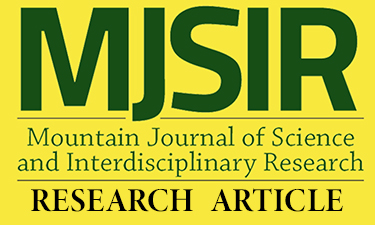Factors Influencing Mathematics Teaching as a Career Choice (FIMT-Choice): An Instrument Development and Validation
Main Article Content
Abstract
The study developed and validated an instrument that assess the motivations of secondary mathematics pre-service teachers (SMPTs) in choosing mathematics teaching as their career, hereto referred as Factors Influencing Mathematics Teaching as a Career Choice (FIMT-Choice). The study adopted items from Factors Influencing Teaching as a Career Choice (FIT-Choice) instrument by Watt and Richardson and calibrated or added items suited to the local area. The notion that content mathematics could be among the motivations of secondary pre-service teachers in choosing math-teaching career was also considered. The study generated 56 final items in the FIMT- Choice instrument, which were validated among 171 secondary mathematics pre-service teachers (SMPTs) in two prominent teacher education institutions in the Cordillera Administrative Region, Philippines. Statistical tools such as Cronbach’s Alpha, Bartlett's Test of Sphericity, Kaiser-Meyer-Olkin Measure of Sampling Adequacy and the Principal Component Factor Analysis were used to establish the reliability and validity of the instrument. The results suggest that the SMPTs consider 10 valid and reliable constructs in choosing mathematics teaching as their career. Particularly, the SMPTs separate the mathematics, the teaching, and the combined mathematics teaching aspects in their motivations in entering the mathematics-teaching career. Thus, the FIMT-Choice Scale assess more specific areas of motivations in choosing mathematic- teaching as a career among SMPTs compared with the FIT-Choice Scale by Watt and Richardson. Hence, the FIMT- Choice Scale is a more precise instrument in exploring the motivations of SMPTs in entering the methematics teaching career.
Article Details
References
Brok, den, P.J., Want, van der, A.C., Claessens, L.C. A., Pennings, H.J.M., Wubbels, T., Brekelmans, J.M. G., & Tartwijk, van, J.W.F. (2013). Teachers’ choices for the teaching career and their teacher-student interpersonal relationships in the classroom. In W.G. Tierney, & K.A. Renn (Eds.), Education and Poverty: Theory Research, Policy and Praxis; Annual meeting of the American Educational Research Association, 26 April – 1 May 2013, San Francisco,California (pp. 1-20). Washington, DC:AERA.
CHED Memorandum Order No. 30, series of 2004. Revised Policies and Standards for Undergraduate Teacher education Curriculum. Commission on Higher Education (CHED), Republic of the Philippines.
CHED Memorandum Order No. 52, series of 2007. Addendum to CMO 30, Series of 2004 Entitled "Revised Policies and Standards for Undergraduate Teacher education Curriculum". Commission on Higher Education (CHED), Republic of the Philippines.
Curtis, C. (2011). Why do they choose to teach – and why do they leave? A study of middle school and high school mathematics teachers. Education Journal, 132(4): 779-788.
Good, D. (1993). Preservice Teachers Motivations for Choosing Teaching as a Career (Unpublished Doctoral Dissertation). The Ohio State University, Columbus .
Kilinc, A., Richardson, P. W., & Watt, H.M.G. (2012). Factors influencing teaching choice in Turkey. Asia-Pacific Journal of Teacher Education, 40(3): 199-226.
Low, E.L., Lim, S.K., Ch’ng, A., & Goh, K.C. (2010). Pre-service Teachers’ Reasons for Choosing Teaching as a Career in Singapore. Asia Pacific Journal of Education, 31(2): 195-210.
Lubrica, M.A.B. (2005). Probability and Statistics. C & E Publishing Inc. 839 EDSA, South Triangle, Quezon City, Philippines. Professional Regulation Commission. (2016). Results of Licensure Examination for Teachers. Retrieved from www.prc.gov.ph.
Richardson, P.W., & Watt, H.M.G. (2006). Who chooses teaching and why? Profiling characteristics and motivations across three Australian universities. Asia-Pacific Journal of Teacher Education, 34(1): 27-56.
Rots, I., & Aelterman, A. (2009). Teacher education graduates’ entrance into the teaching profession: Development and test of a model. European Journal of Psychology of Education, 24(4): 453-471.
Topkaya, E.Z., & Uztosun, M.S. (2012). Choosing teaching as a career: Motivations of pre-service english teachers in Turkey. Journal of Language Teaching and Research, 3(1): 126-134.
Watt, H.M.G., & Richardson, P.W. (2007). Motivational factors influencing teaching as a career choice: Development and validation of the FIT-Choice scale. Journal of Experimental Education, 75(3): 167-202.
Watt, H.M.G., & Richardson, P.W. (2008). Motivations, perceptions, and aspirations concerning teaching as a career for different types of beginning teachers. Learning and Instruction, 18: 408-428.
Watt, H.M.G., & Richardson, P.W. (2012). An introduction to teaching motivations in different countries: comparisons using the FIT-Choice scale. Asia-Pacific Journal of Teacher Education, 40(3): 185-197.
Watt, H.M.G., Richardson, P.W., Klusmann, U., Kunter, M., Beyer, B., Trautwein, U., & Baumert, J. (2012). Motivations for choosing teaching as a career: An international comparison using the FIT-Choice scale. Teaching and Teacher Education, 28: 791-805.
Yuce, K., Sahin, E.Y., Kocer, O., & Kana, F. (2013). Motivations for choosing teaching as a career: A perspective of pre-service teachers from a turkish context. Asia Pacific Educ. Rev., 14: 295-306.
Zelkowski, J., Gleason, J., Cox, D.C., & Bismarck, S. (2013). Developing and validating a reliable TPACK instrument for secondary mathematics preservice teachers. Journal of Research on Technology, 46(2): 173-206.
Zhao, K. (2011). Motivations to become teachers in Canada: Perceptions from internationally educated teachers. International Journal for Cross-Disciplinary Subjects in Education, Special Issue, 1(1).

